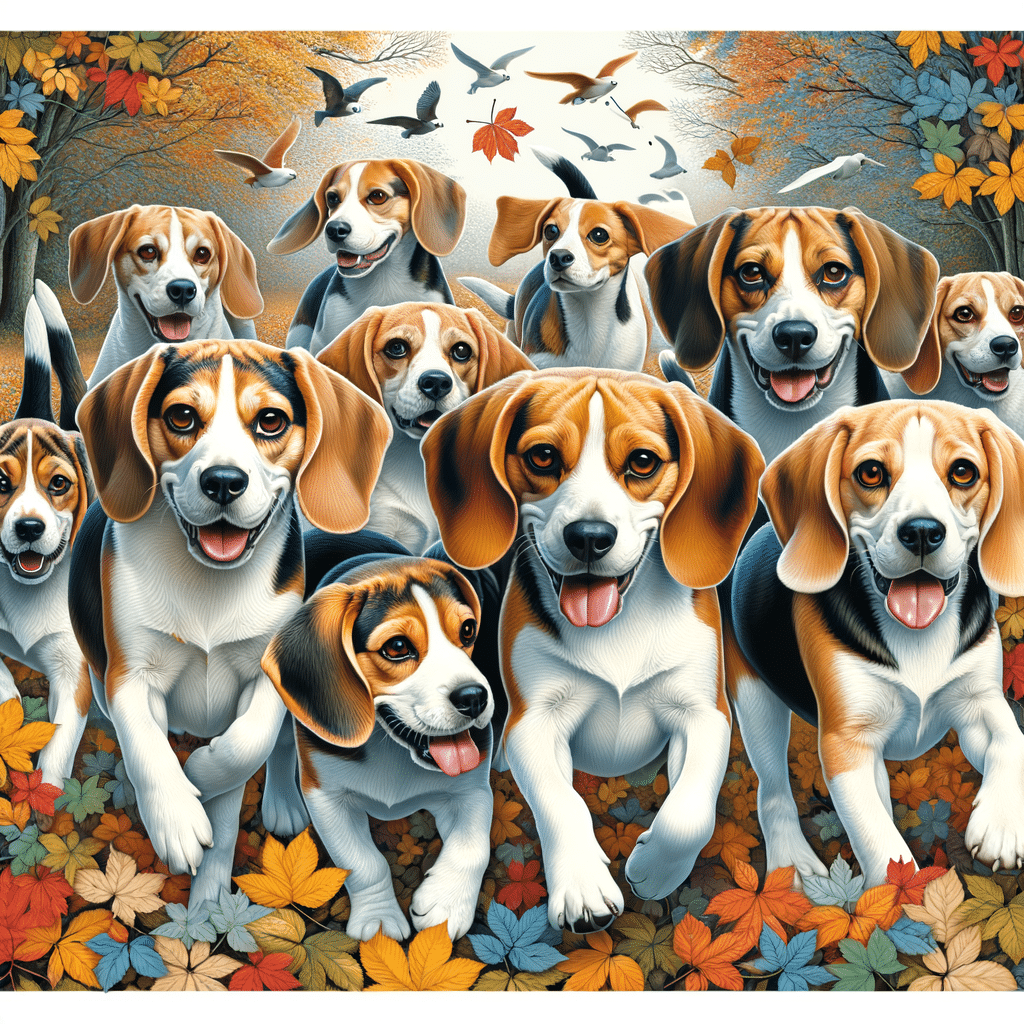When considering a beagle as a pet, apartment dwellers often wonder if this breed suits life in a smaller apartment. Beagles are a popular dog breed for their size, friendliness, and low-maintenance grooming needs. These small to medium-sized dogs have historically been bred for hunting, with an innate need for regular walks and a propensity for vocalization.
In This Article
In This Article
- Beagle Traits and Apartment Living
- Managing Beagle Behavior in an Apartment
- Creating a Suitable Home Environment
- Alternative Dog Breeds for Apartments
- Frequently Asked Questions
Despite their energetic nature, many beagle owners keep their companions happy and healthy in small space apartments. This adaptability is contingent on regular exercise and mental stimulation to manage their high energy levels and curb potential separation anxiety. Moreover, creating a suitable home environment with plenty of social interaction can help mitigate some challenges associated with keeping a beagle in an apartment, such as their tendency to vocalize.
Highlights
- Beagles can adapt to apartment life with proper exercise and mental stimulation.
- Regular interaction and a structured routine help manage beagle behaviors like vocalization and anxiety.
- The suitability of beagles for apartment living also depends on providing an appropriate home environment.
Beagle Traits and Apartment Living
Beagles are small, adaptable dogs known for their friendly temperament, which can make them suitable for apartment living when their needs are considered.
Size and Space Considerations
Beagles are relatively small dogs, typically weighing 20 to 30 pounds, making them manageable for apartment dwellers. Space considerations for a beagle in an apartment include ensuring enough room for the dog to move comfortably and for the owner to store all necessary pet-related items, such as a dog bed, toys, dog food, and water bowls.
Beagle Temperament and Social Needs
A beagle’s temperament is generally even-tempered, and it is known for its friendly nature. It usually gets along well with kids and is eager for social interaction, making it a pleasant companion in a multi-person household. However, beagles can sometimes exhibit separation anxiety, which may lead to destructive behavior if left alone for too long.
Exercise and Stimulation
Beagles have moderate to high energy levels and require sufficient daily exercise, such as regular walks and playtime. Providing regular mental stimulation in an apartment setting is important to prevent boredom. Activities like puzzle toys can help meet their needs for engagement. Owners should plan to incorporate activity into their daily routine to ensure their beagle remains healthy and happy.
Managing Beagle Behavior in an Apartment
Successfully managing a beagle’s behavior in an apartment primarily revolves around consistent training, addressing vocal tendencies, averting destructive behaviors, and maintaining grooming standards for cleanliness.
Training for Apartment Living
Training a beagle for apartment living starts with obedience training. Commands like sit, stay, and come are essential. Potty training is crucial to avoid accidents inside. Owners should use positive reinforcement to encourage desired behaviors, offering treats or praise as rewards.
Dealing with Barking and Noise
Beagles can be vocal, and addressing barking is a common concern. Training them to respond to the “quiet” command is essential. Positive reinforcement for non-vocal behavior helps ensure they get adequate exercise to minimize anxiety-driven howling or barking.
Preventing Destructive Behavior
Beagles may exhibit destructive behavior due to boredom or separation anxiety. To prevent this, provide plenty of exercise and mental stimulation for your beagle with interactive dog toys. If needed, training them to be comfortable in a crate while alone can ensure both safety and prevent unwanted behaviors.
Grooming and Cleanliness
Consistent grooming is necessary to manage shedding and maintain a clean living space. Beagles have moderate grooming needs, including regular brushing to minimize shedding and control smell. Nail trimming and ear cleaning are also part of a regular grooming routine to keep them tidy.
Creating a Suitable Home Environment
Adapting their living space to meet the breed’s needs is essential for beagle owners living in apartments. A well-thought-out home environment can balance the beagle’s high energy levels and the spatial limitations of apartment living.
Providing Adequate Exercise Space
Beagles have significant energy and require daily exercise to stay healthy and happy. Apartment dwellers should ensure their beagle has access to outdoor spaces for exercise. This might involve scheduling multiple daily walks and arranging playtime in nearby parks. Interactive toys can help keep beagles entertained indoors when outdoor space is limited.
Consider the following:
- Daily walks: At least two to three per day.
- Interactive play: Use toys that stimulate their hunting instincts.
Ensuring Safety and Comfort
Safety in an urban environment is paramount for beagles. They should always be on a harness outside to prevent them from chasing scents, a characteristic of scent hounds like them. Inside the apartment, create a safe space with a crate for comfort and reduce anxiety when left alone.
Ensure the following for a comfortable environment:
- A secure harness for all outside time.
- A well-ventilated and cozy crate for a feeling of security.
Selecting the Right Accessories
Choosing the right accessories can help keep your beagle safe and engaged at home. Durable chew and scent-based toys can cater to their sense of smell and keep them occupied. Moreover, a proper leash and collar for safe walks are crucial in an urban setting.
Incorporating Regular Routines
Beagles are intelligent dogs that thrive on consistency, and establishing regular routines is beneficial, especially in the absence of a backyard. Consistent feeding times, walks, playtime, and grooming can help prevent anxiety and meet their exercise requirements. If long work hours keep you away, consider a dog walker or doggy daycare for their midday exercise.
Alternative Dog Breeds for Apartments
When selecting a dog breed for apartment living, potential owners should consider size, exercise needs, vocal tendencies, and grooming requirements. The following breeds offer characteristics that suit an apartment environment.
Small and Quiet Dog Breeds
Bichon Frise: This small breed is known for its quiet demeanor. With its fluffy coat and friendly personality, it makes an excellent companion in small spaces.
Cavalier King Charles Spaniel: This breed is not only small in stature but also typically calm and quiet, making it an ideal pet for apartment dwellers looking for a less vocal canine friend.
Dog Breeds with Low Exercise Needs
Bulldog: Bulldogs require minimal exercise and are well-suited to the apartment lifestyle. Their laid-back nature makes them happy to lounge around the home.
Pug: Pugs are another breed that does not demand extensive physical activity. They’re content with short walks and indoor play, fitting for a smaller living space.
Breeds Known for Being Less Vocal
Shih Tzu: The Shih Tzu is a good choice for those seeking a less vocal dog. It is known for being relatively quiet and ideal for maintaining a peaceful apartment setting.
Cavalier King Charles Spaniel: As mentioned for its small size, these spaniels are also not very vocal, which helps avoid disturbing neighbors in close living quarters.
Other Considerations for Selecting an Apartment Dog
When choosing a dog for your apartment, always consult the landlord or review the lease to ensure pets are allowed. You should also factor in the dog’s size and exercise requirements to match your living space and lifestyle. Consider grooming needs as well, as some dogs may require regular professional grooming, which can be an additional consideration in terms of space and budget.
While some dog breeds like the Bichon Frise and Shih Tzu are small and generally quiet, they may require regular grooming. On the other hand, breeds like the bulldog may have low exercise requirements but could need attention to wrinkles and skin folds. As a pet owner in an apartment, these considerations are crucial to ensure a harmonious living situation for you and your dog.
Frequently Asked Questions
Potential owners typically have several concerns when considering a beagle as a pet for apartment living, ranging from the breed’s adaptability to space constraints to the dog’s exercise needs.
What factors make a beagle suitable or unsuitable for apartment living?
Beagles are small to medium-sized dogs, which can make them suitable for apartment living space-wise. However, they are also known for being vocal and having high energy levels, which could be challenging in an apartment setting.
How can beagle owners manage their dog’s energy and exercise needs in an apartment?
Owners can manage their beagle’s energy by providing regular walks, interactive playtimes, and mental stimulation through puzzle toys. Daily exercise is crucial to prevent destructive behavior due to pent-up energy.
What are the considerations for leaving a beagle alone in an apartment during work hours?
Beagles can suffer from separation anxiety if left alone for extended periods. Owners should consider crate training, leaving engaging toys, or arranging a dog walker to break up the day and alleviate anxiety.
What are some tips for first-time dog owners choosing a beagle for an apartment lifestyle?
First-time dog owners should ensure they have the time to provide adequate exercise and mental stimulation for a beagle. Additionally, they should puppy-proof their apartment and consider obedience training to manage potential behaviors like excessive barking.
How do beagles typically adapt to an indoor living environment?
Beagles adapt well to indoor living with enough exercise and attention. Their pleasant and friendly nature allows them to enjoy indoor activities with their owners.
What are some common challenges associated with owning a beagle in an apartment?
The everyday challenges of owning a beagle in an apartment include managing their tendency to bark or howl, ensuring sufficient exercise, and dealing with possible separation anxiety when left alone.






